Media | Articles
Why on earth is an IROC Camaro worth more than a C4 Corvette?
There’s a certain order of things in the car industry. Some brands and badges just sit higher up on the totem pole of price than others. A Lincoln is more expensive than a Ford, a Lexus more expensive than a Toyota, a 5 Series than a 3 Series, etc. Convention also dictates that a Corvette is supposed to be pricier than a Camaro.
That’s certainly the case when shopping for new cars in 2022, and it was the case in 2012, 2002, 1992 and way on back. If Chevrolet’s pony car is the working man’s whip, America’s sports car is what the owner of the company he works for drives. If the Camaro is attainable, the Corvette is aspirational. You get the idea.
So what?
When going over our quarterly updates to the Hagerty Price Guide recently, we realized the status quo has been upset for a certain Chevy performance pair, specifically from those mustachioed muscle years of the 1980s.
Not only is a Camaro IROC-Z (1985–90) worth more than the equivalent base C4 Corvette (1984–96), it’s worth a lot more. More than twice as much, actually, and this reversal of things predates both the recent boom in interest for all things ’80s cars and ’80s revival events like Radwood.
Marketplace
Buy and sell classics with confidence
We have a major market anomaly on our hands, then. The situation is sort of like booking a guided African safari for cheaper than a trip to the local zoo, or eating at a restaurant whose steak is cheaper than the burger. To try and understand this contradiction, we found a pair of these star-spangled mullet-mobiles—Sajeev Mehta’s 1985 Corvette and Kay Yasoni’s 1988 Camaro IROC-Z —for a back-to-back drive on a (finally) cool fall morning in Houston, Texas.
We wanted to find out if, perhaps, modern car collectors are on to something that wasn’t obvious to General Motors product planners in the 1980s.
That wouldn’t be unheard of. Some of the hottest cars on the market were, at one point, thought to be attainable or less. A Mini Cooper from the 1960s can easily be worth as much or more than some contemporary Rolls-Royces; a Mazda MX-5 Miata can easily bring more money than contemporary Cadillacs and Lincolns—and that kind of makes sense.
This sort of thing happens all the time in other markets. Vincent Van Gogh died a failure. Now his works are priceless.
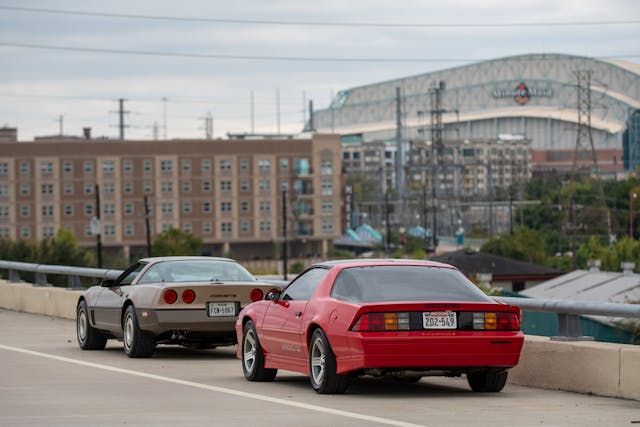
Debuting in 1982 and 1984, respectively, the third-gen Camaro and the fourth-gen Corvette were the right cars at the right time for General Motors. Both of their predecessors were long-in-the-tooth and near-caricatures of their former selves by the early ’80s. Thanks to computer-aided design, fuel injection and more sophisticated suspension, the General finally pulled these American sports cars out of the malaise era.
“We needed to get the Corvette back to the performance level of 1970,” said Dave McLellan, the Corvette’s chief engineer during the C4 years. Chevy mostly pulled it off, with Car and Driver calling the first all-new Corvette in 20 years “a true-born, world-class sports car loaded with technical sophistication.”
The Camaro, meanwhile, was another breath of fresh air that brought a completely new look to Chevy’s pony car, leading Motor Trend to award it Car of the Year honors for 1982.
The Z28 was the speediest Camaro upon the third gen’s debut in 1982, but from 1985 to ’90 the top dog in the lineup was the IROC-Z Sport Equipment package, often shortened by funny-haired gearheads everywhere to simply “IROC.”
The $659 option took its name from the International Race of Champions, a race series pitting the stars of NASCAR, Indy, and sports car racing against each other in identical Chevy Camaros.
The actual IROC race cars weren’t much more than Camaro-shaped shells on top of a NASCAR tube chassis. But, like any good car company, Chevrolet was never one to miss a marketing opportunity and slapped IROC decals and a body kit on its latest flagship Camaro. Uprated suspension, bigger sway bars, upgraded wheels and tires, fog lights, and a choice of V-8 engines came with the stickers.
For the second half of the 1980s, the IROC was the Camaro to have, with the most power and, of course, the most flash.
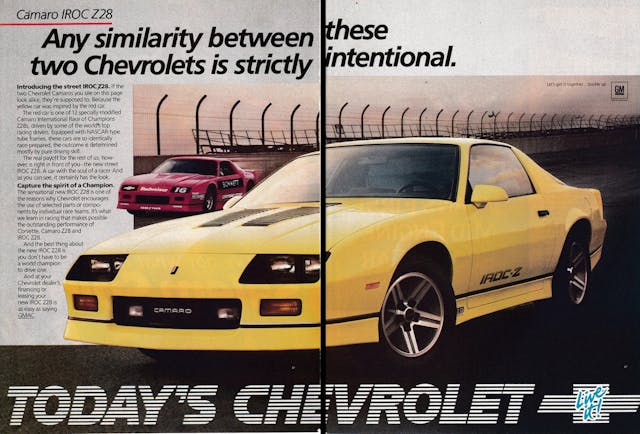
For 1988, Chevrolet slimmed down the Camaro lineup by dropping the LT and Z28 models, leaving only the base coupe and the IROC-Z. Although a taller final drive was paired with the 350 engine, its output kept rising, up to 245 horses for 1990. The International Race of Champions series began using Dodge Daytonas in the ’90 season, so Chevy dropped the IROC-Z package in 1991, reinstating the Z28 as the range-topper.
Owner Kay Yasoni’s IROC is a bone-stock, Bright Red ’88 model with the desirable L98 350 and T-tops, and it has gotten the kind of restoration work normally seen on older, more valuable pony cars. Maybe it’s the color, or maybe it’s because I haven’t seen such a clean third-gen Camaro in 20 years, but this car looks fantastic, even next to the Corvette that was supposed to be the premium offering. Its wedgey angles have aged well.
The inside is straightforward ’80s GM (plastic, lots of plastic) with gray cloth seats and right angles everywhere with square vents, stereo, and switchgear. The only things that are round, other than the leather-wrapped steering wheel, are the simple gauges—speedo on the left, tach on the right, and auxiliary readouts in the middle. It’s more restrained than one might expect for a decal-laden performance car named after a race series, but it is functional.

Easy-to-remove glass T-tops offer a clear view of the sky above, and aside from a hint of red fenders and hood vents, there’s a panoramic view of the road ahead as well. I may have forgotten my Whitesnake cassette, but it turns out I didn’t need it—driving this IROC turns back the clock plenty.
As a performance car, the IROC both then and now leaves something to be desired. As a time machine, though, it’s hard to beat. It’s a fun car that people fall in love with it because it brings back memories and feels very of-its-era.

The crisp body produced 24 percent less drag than the C3, the rear hatch offered more space for luggage, and the clamshell hood offered more room to service the engine. A “uniframe” chassis combined a traditional rail frame with separate frames for the windshield and B-pillar. A removable targa roof bolted in between the A- and B-pillars.
Front A-arms and spindles were computer-designed and for the first time and made from forged aluminum, while the compact multilink rear suspension sported a transverse fiberglass leaf spring. An all-digital instrument cluster gave off Tron vibes in a time when most cars had only recently gotten an itty-bitty digital clock.
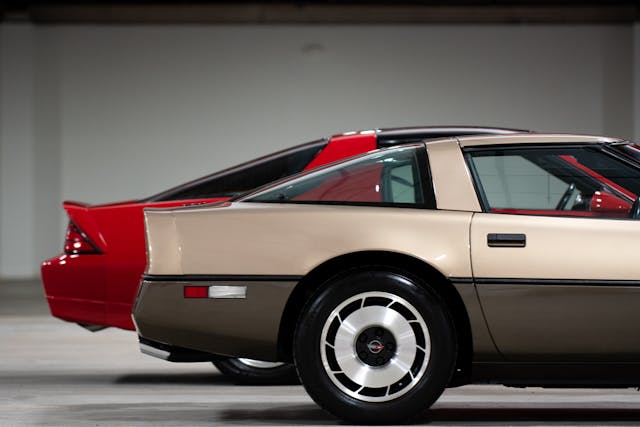
Despite that, initial reviews complained of the new Vette’s jarring ride as well as incessant creaking and rattling from the plasticky cabin. GM improved the ’85 Corvette’s ride with softer spring rates, while the 350 cubic-inch, 230-hp L98 engine debuted under the hood. The workhorse L98 would power the base Corvette until it was replaced by the 300-hp LT1 in 1992. Transmissions were still either automatic or, from 1984-88, a “4+3” manual built by Doug Nash that was essentially a traditional four-speed with overdrive on the top three gears.
And even though the IROC has a racy name, the Corvette wouldn’t be America’s sports car without some motorsports history of its own to back up those crossed flags on the hood.
In SCCA Showroom Stock GT racing, C4s swept the Playboy and then Escort Endurance Championship from 1985–87, and there was nothing the Porsche 944 Turbos could do to stop them. So dominant were the Corvettes that they were booted into the single-marque Corvette Challenge series.
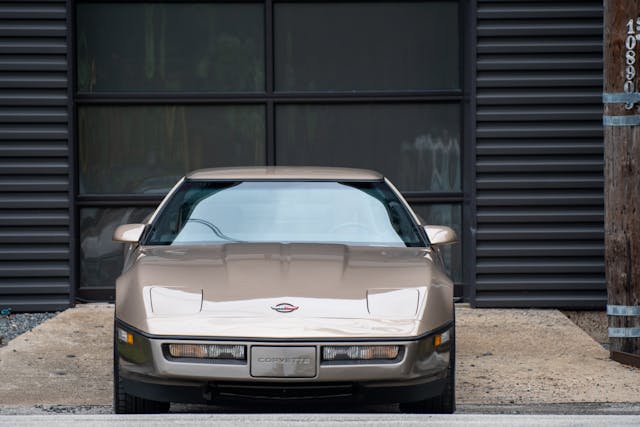
The enormous door sills make getting in and out of a C4 a challenge for anyone, least of all for the 50-somethings who typically buy Corvettes. They say you shouldn’t wear a skirt when driving one of these cars, but it’s awkward no matter what you’re wearing.
If the Camaro’s interior is a cabin, the C4’s is a cockpit. A slightly cramped one that nestles you in between the aforementioned sill and an equally tall transmission tunnel, the green and orange glow of that arcade-game instrument cluster greeting you from behind the two-spoke steering wheel.
If squeaks and rattles were standard factory equipment on the C4, as the old joke goes, they left them out when building this one. It was no noisier than the Camaro. We didn’t take the roof off, though, which in a C4 allows the body to flex and creak through corners and over bumps.
Even with the roof on, a C4 lumbers and rolls through corners more than one might expect, feeling planted but certainly not light on its feet. Step on the go-pedal, though, and the car livens up, feeling as though its 230-horse, 330 lb-ft torque ratings are delivering more than what the digital speedometer is reading (a hybrid-analog-digital dash arrived in 1990; dim or failing gauges are common on the earlier cars).
These two bowties weigh within a hundred pounds of each other and share the L98 engine, but the Corvette feels considerably quicker.
When the ’80s kitsch falls away, you’re left with a more purposeful sports car than the contemporary Camaro. The Corvette is lower, quicker, more exciting. It’s a more entertaining experience behind the wheel whether you’re driving it or sitting in traffic. Even the interior’s gimmicks and eccentricities lend a sense of occasion missing in the IROC’s sea of plastic.
Of course, this is as it should be. The Corvette was then, as now, GM’s performance flagship and cost more than even a loaded IROC when new (an IROC could get to $20K with options, but the ’85 Corvette started at $24K).
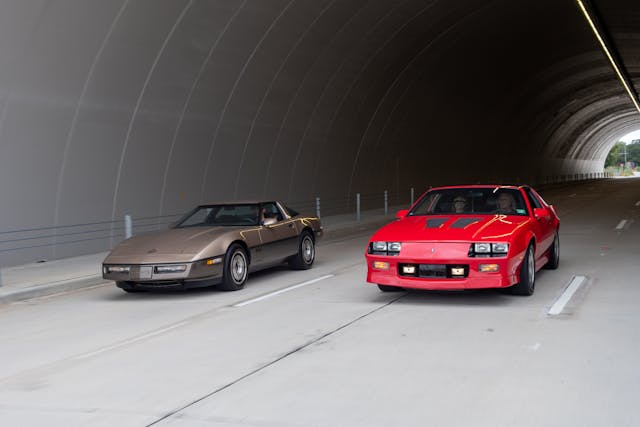
Why are low-mile IROCs storming through Bring a Trailer for prices over $40,000 and even $60,000 while base C4s in similar condition are lucky to sell in the 20s?
There isn’t one big answer, but there may be a few smaller ones. One is the rarity of good-condition IROCs. Chevrolet sold third-gen Camaros by the lot, but IROCs were expensive. Kay’s red coupe is one of 24,050 IROC-Zs sold in 1988, but only about half of that number came with the big engine.
Also, many IROCs lived hard, well-used lives, and as they aged they were frequently left to the elements. Meanwhile, Sajeev’s C4 is one of nearly 40,000 Corvettes sold for ’85, and if the typical IROC buyer was out looking for a stop light drag, the Corvette owner was a middle-aged family man who only drove it on the weekends. As such, the C4 survival rate is higher, the typical mileage lower.
There’s also the fact that while the IROC-Z is top dog among third-gen Camaros, an early C4 has to look at the taillights of Callaways, ZR-1s, Grand Sports, and even later base cars. Mehta’s bronze beauty is a very nice car, but it’s no “King of the Hill” ZR-1 (although even ZR-1s remain relatively affordable).
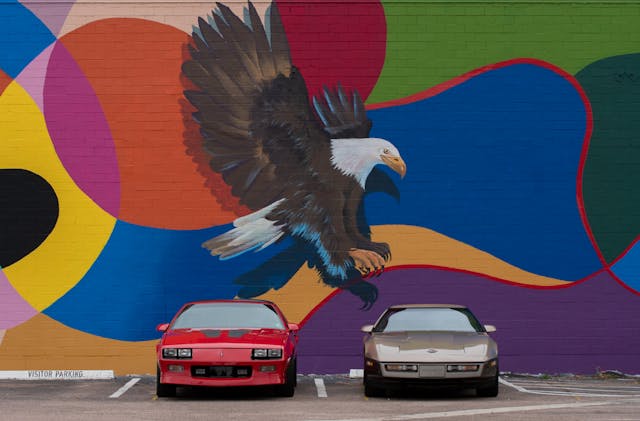
Meanwhile, Gen Xers apparently go gaga for third-gen Camaros. Although Gen Xers make up 32 percent of the market as a whole, they own about half of the IROCs insured with Hagerty. IROC values started to soar in 2014, about when this generation of enthusiasts entered their high-earning, mid-life, fun-car-buying years. That’s probably not a coincidence.
Last but not least, there are impossible-to quantify matters of perspective. Even with the old jokes about mullet-wearing owners, these Camaros really play to nostalgia—a powerful force in any collector market. For those of a certain age, the IROC was the attainable car they dreamed of—the car the coolest kid in your high school might have driven. The C4 Corvette, rightly or wrongly, may be remembered as something your buddy’s dad drove, probably while wearing New Balances and high socks.
Even the C4’s technological advancements might work against it in the minds of collectors. It hails from an era when General Motors squandered a fortune on technical solutions, from paint-shop robots that wound up spraying each other to plastic-bodied compact cars that couldn’t match the refinement of contemporary Hondas. It’s also sort of stuck in a middle ground where it’s too new and electronic to really be considered a “classic” in the sense of a C3, but at the same time it lives in the shadow of the much faster (and today not much pricier) C5.
I still don’t get it, though. The massive gulf in value between these cars that used to share showroom space is just too big to make sense, and if one is undervalued, maybe the other is overvalued. Either way, it’s yet another case of why the car hobby is not always a rational one.
Check out the Hagerty Media homepage so you don’t miss a single story, or better yet, bookmark it.









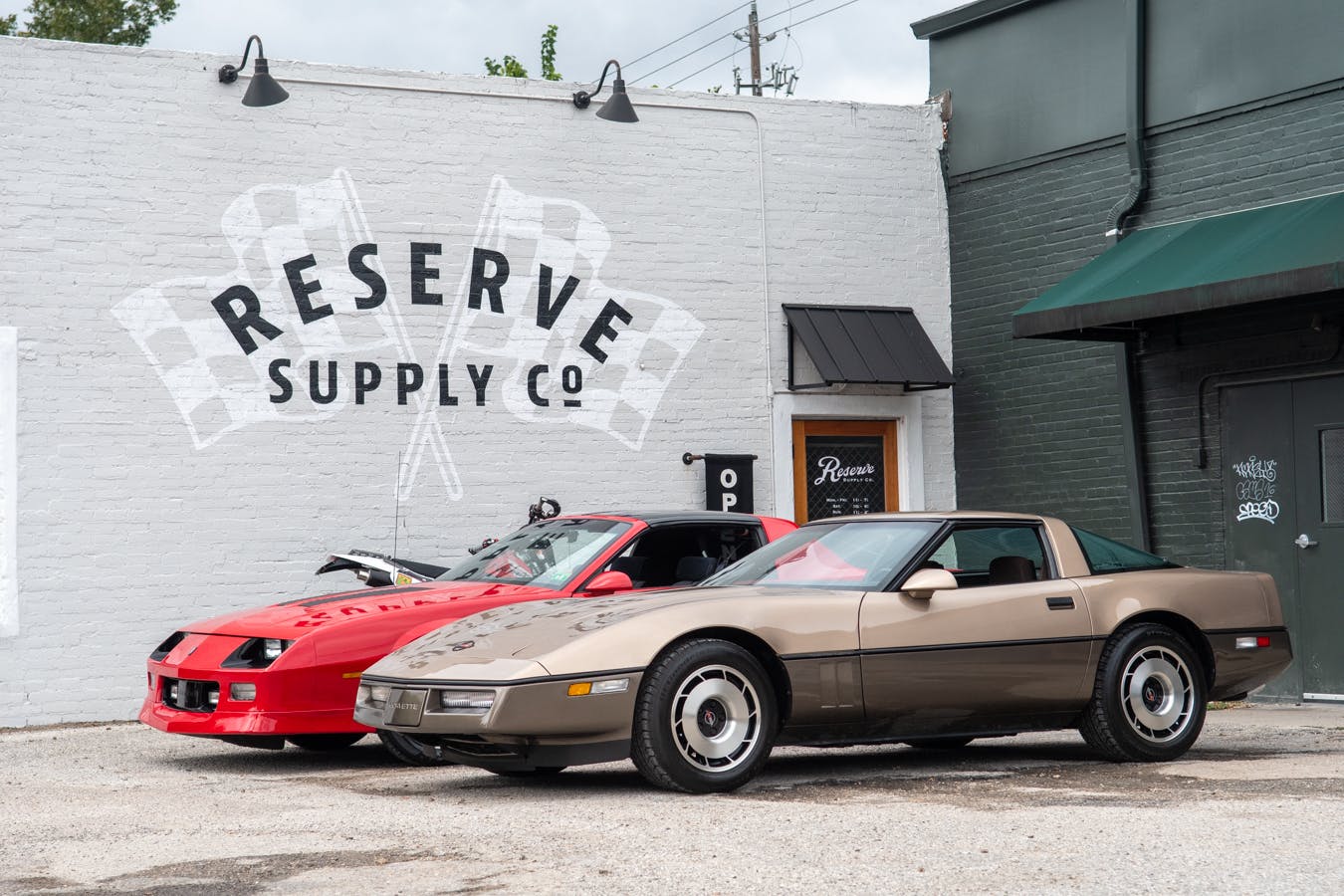
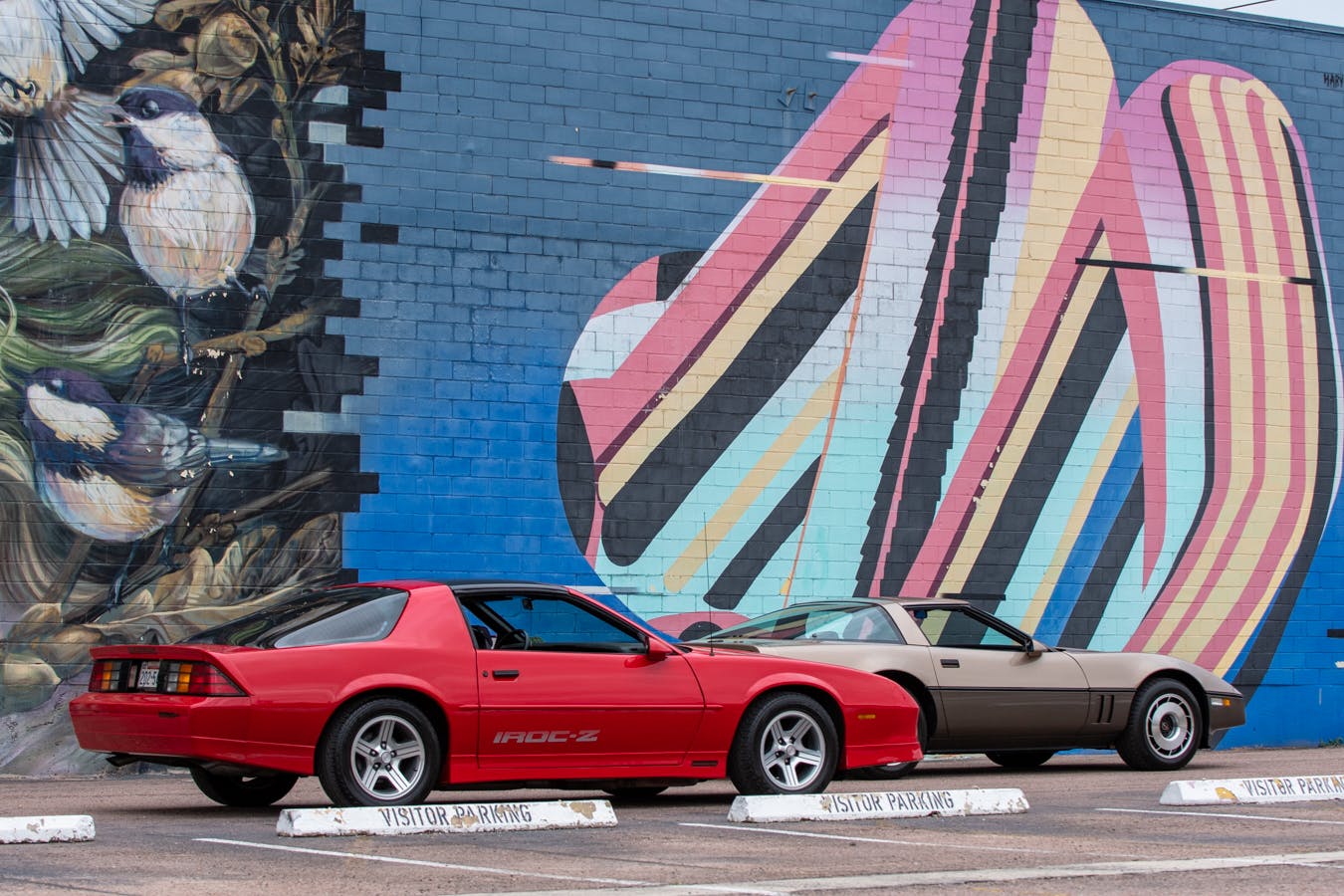

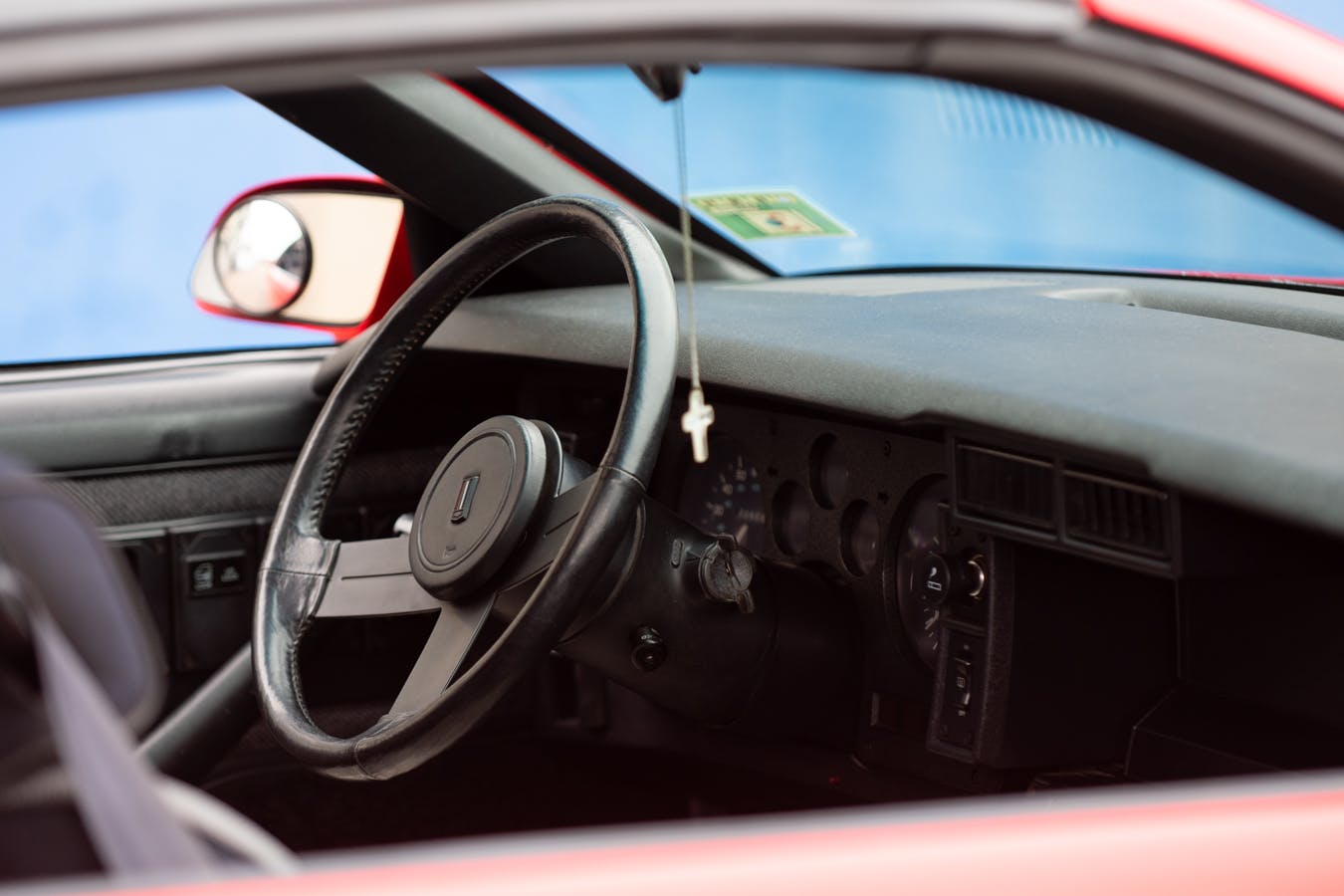
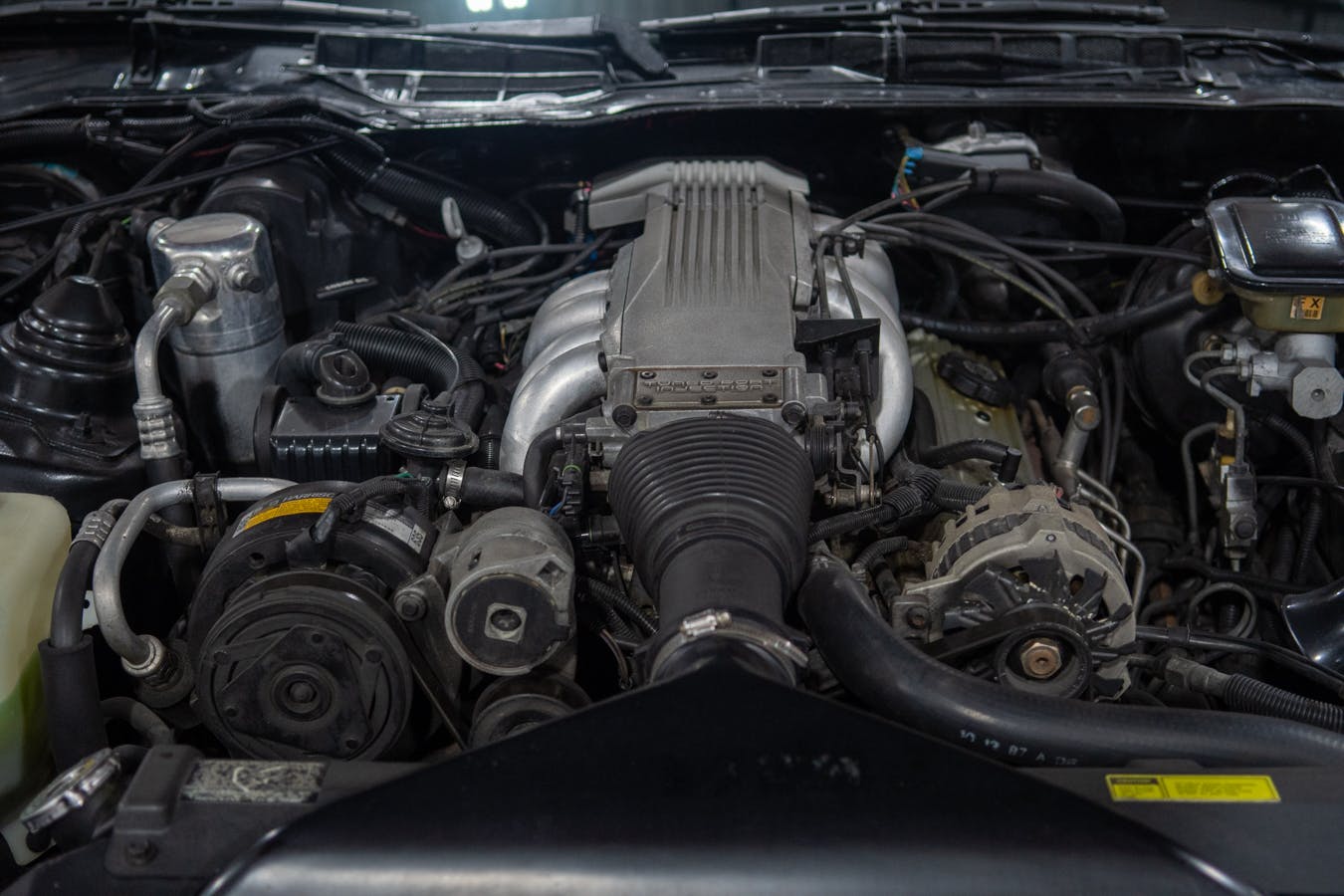
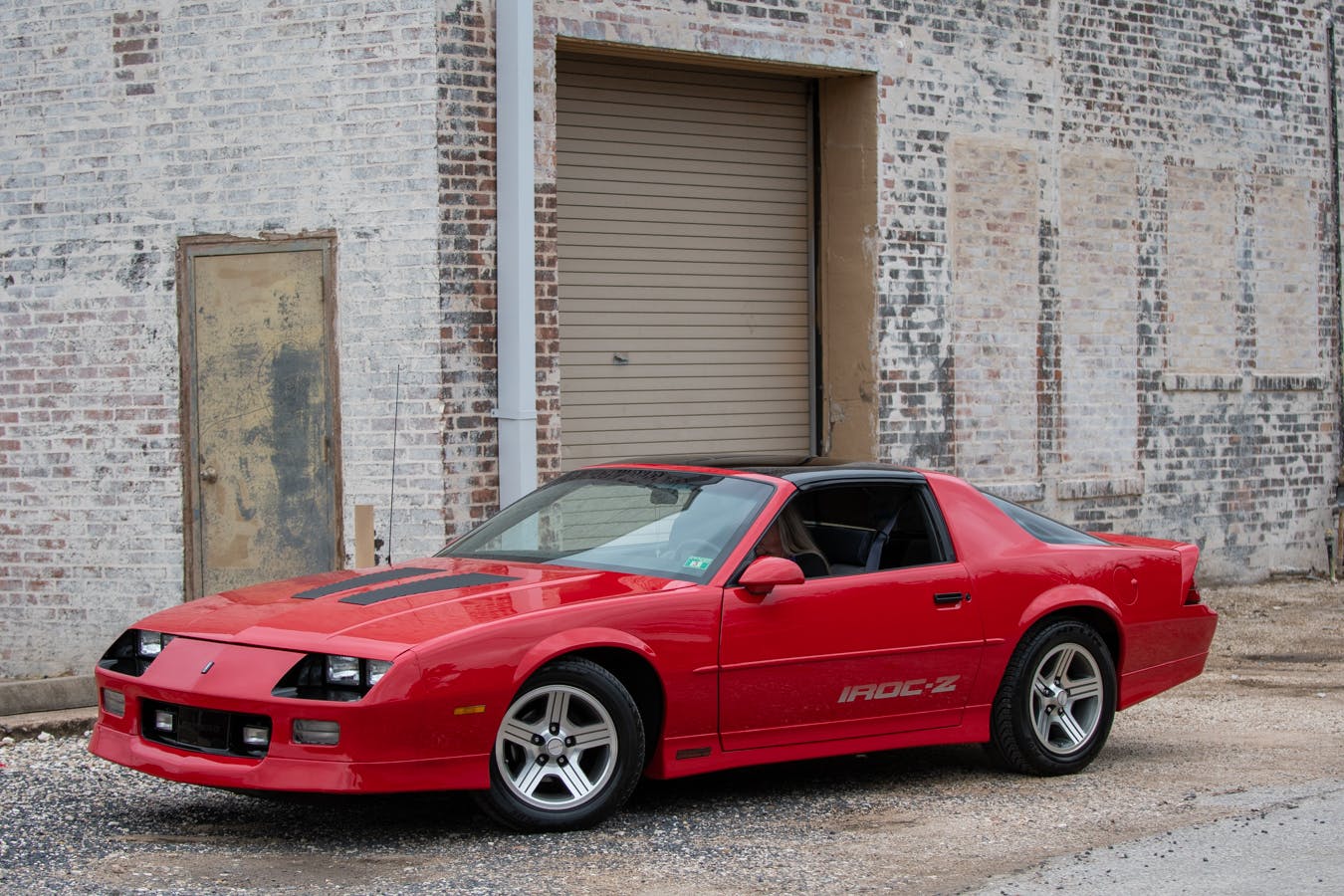
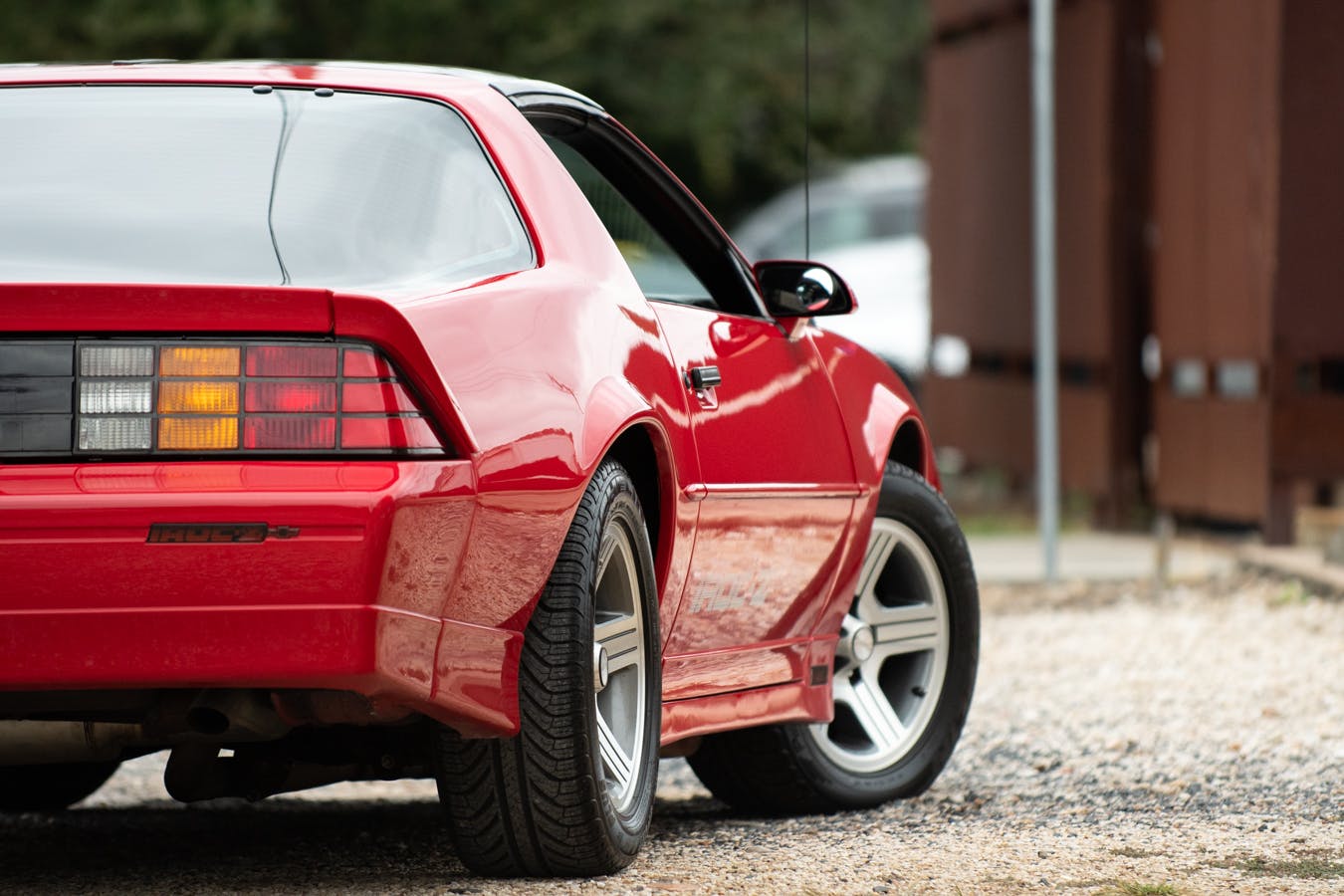


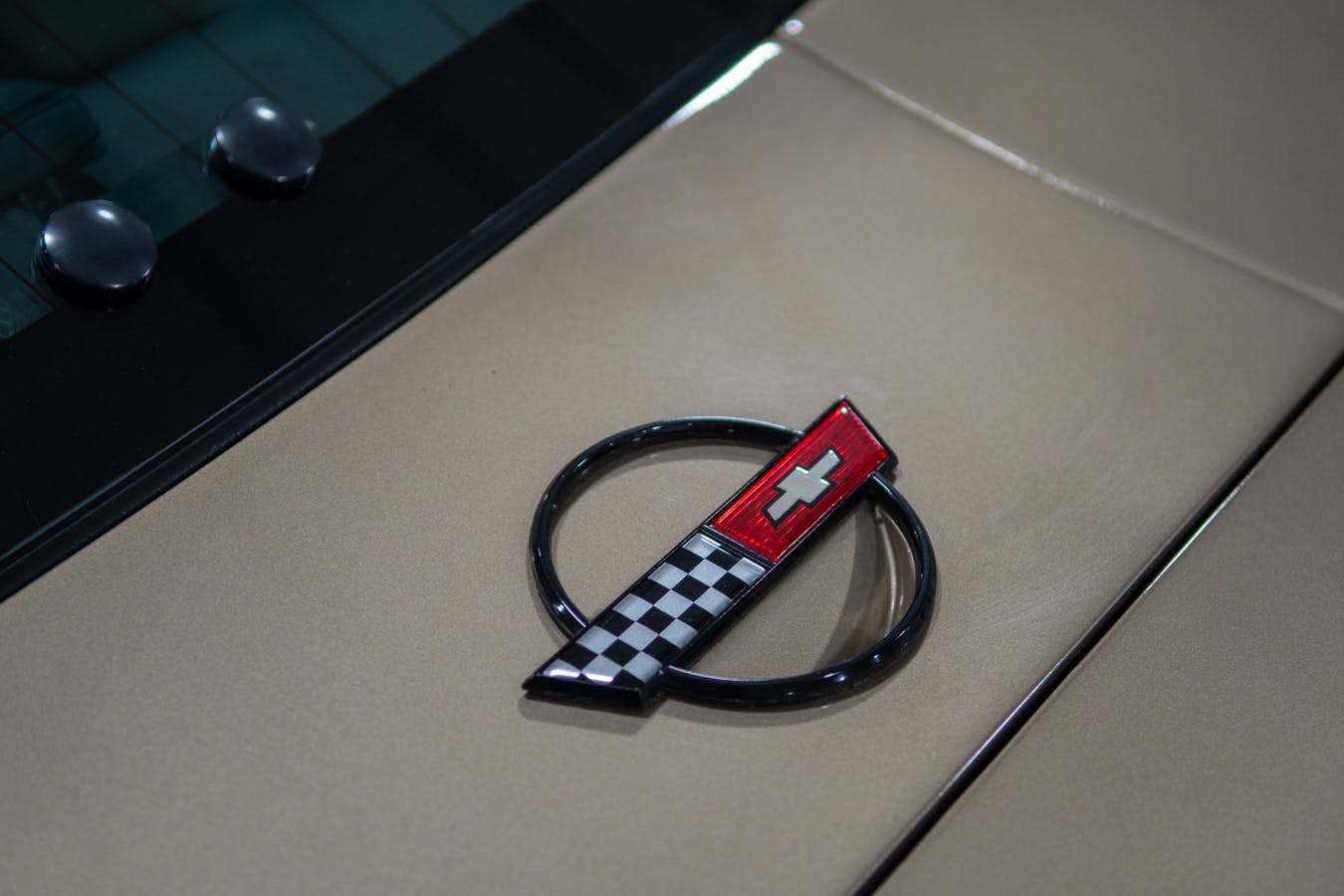
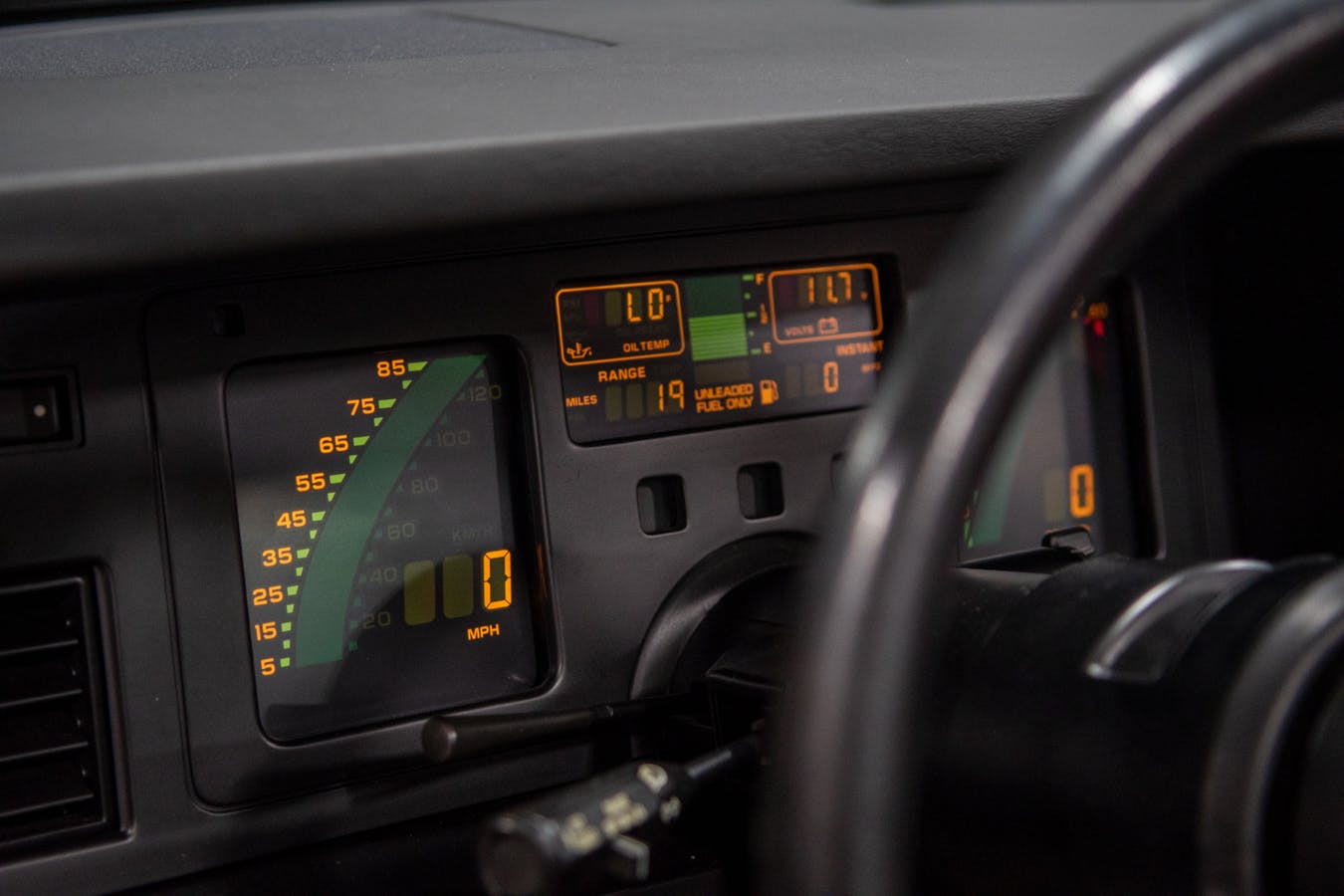
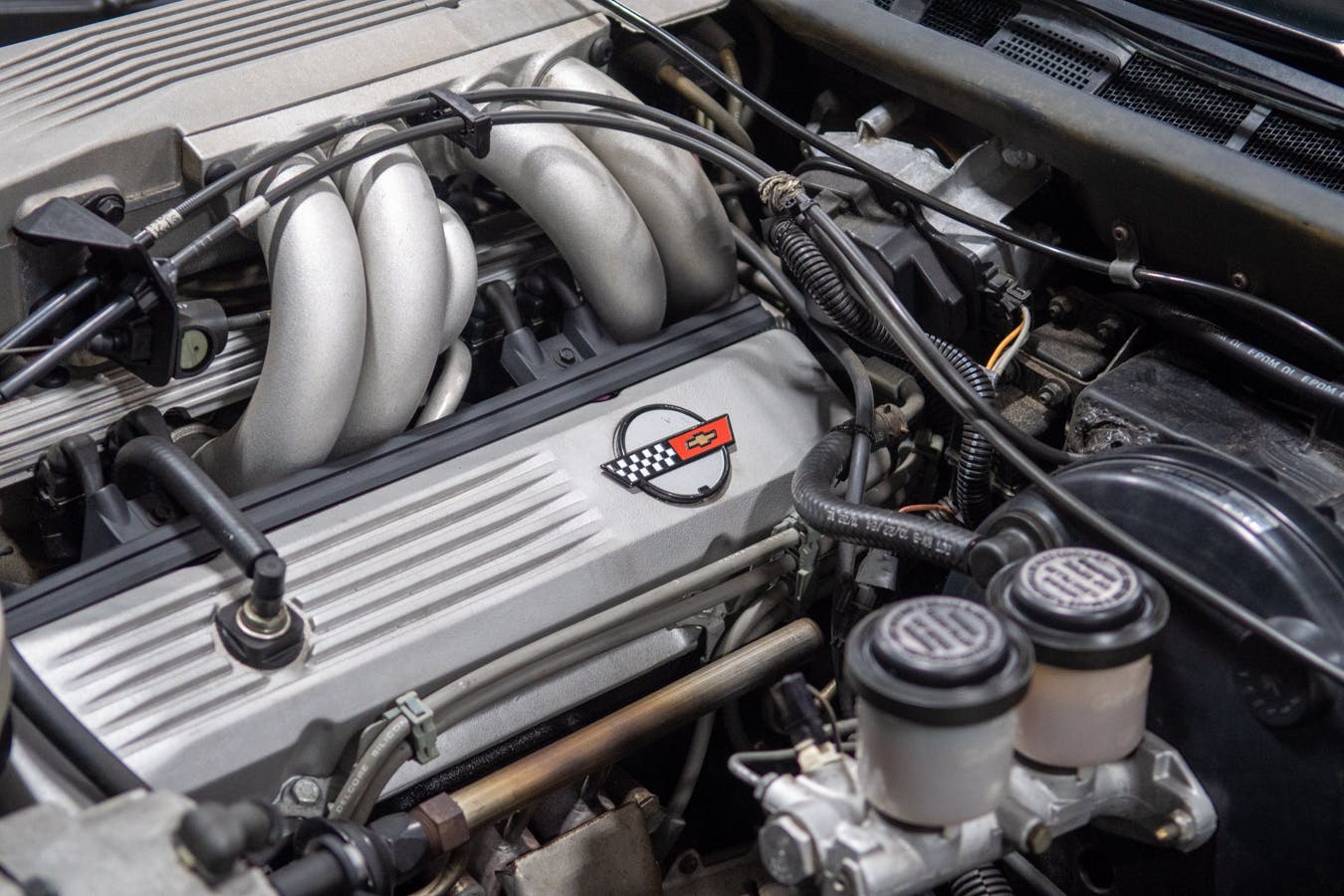
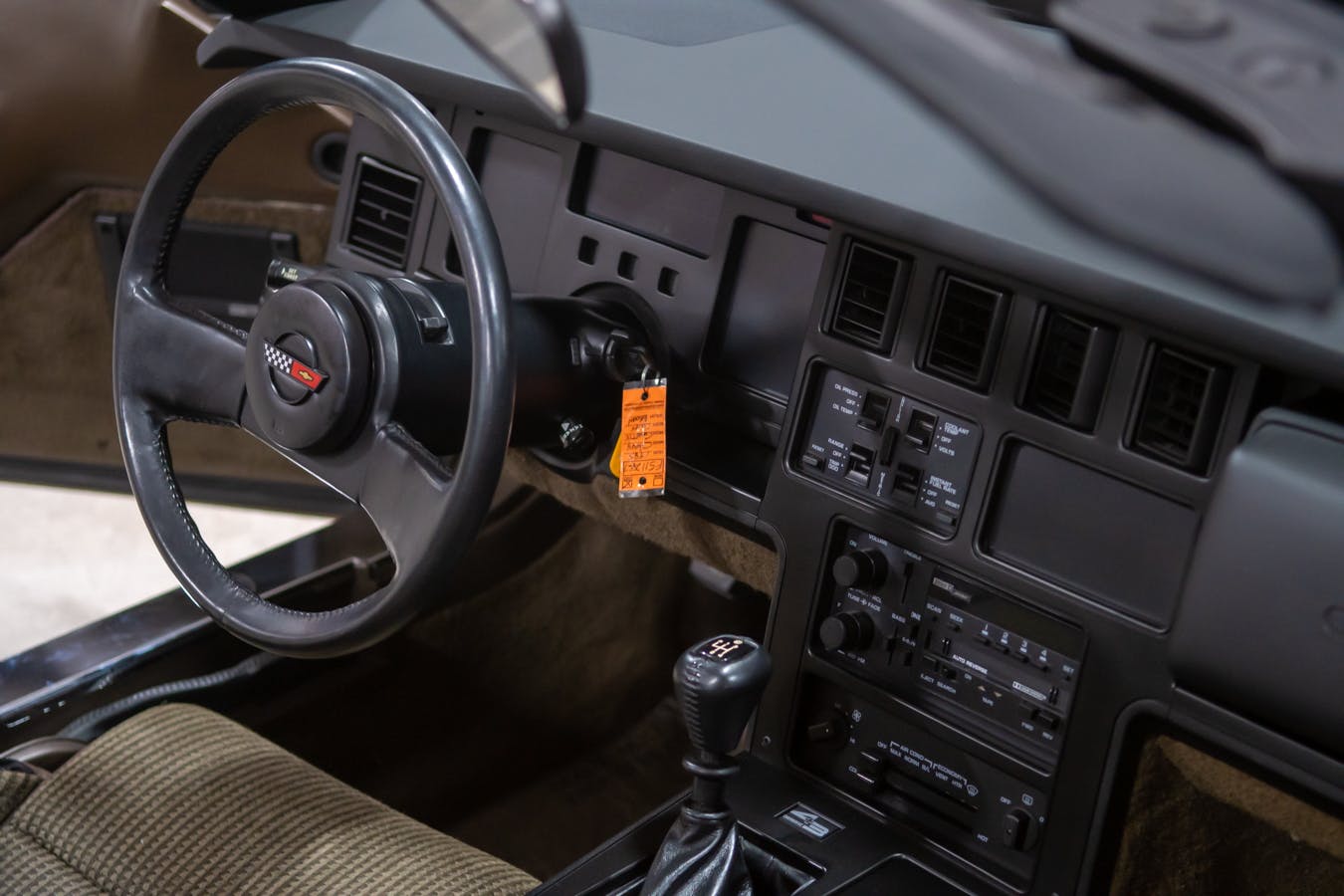
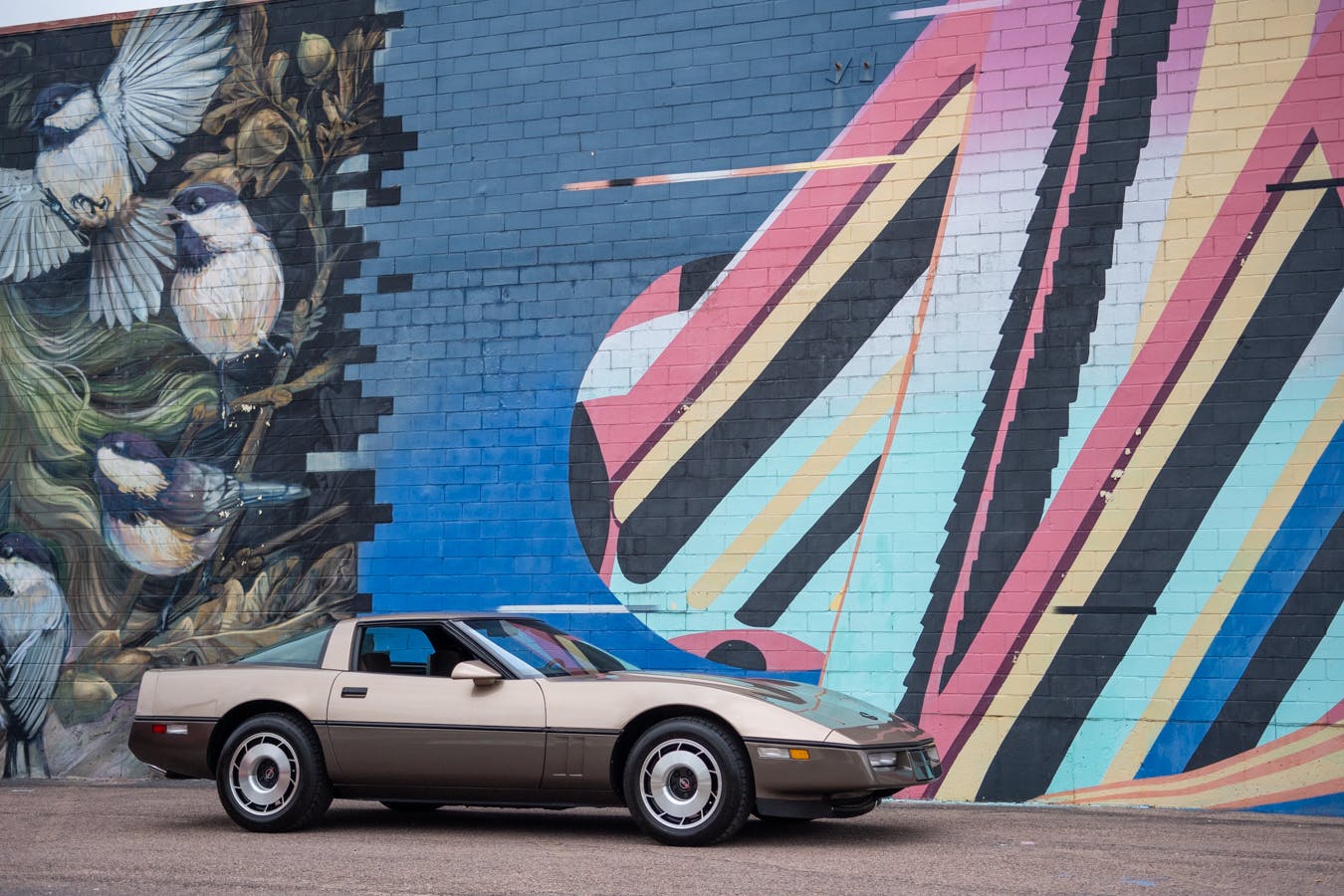
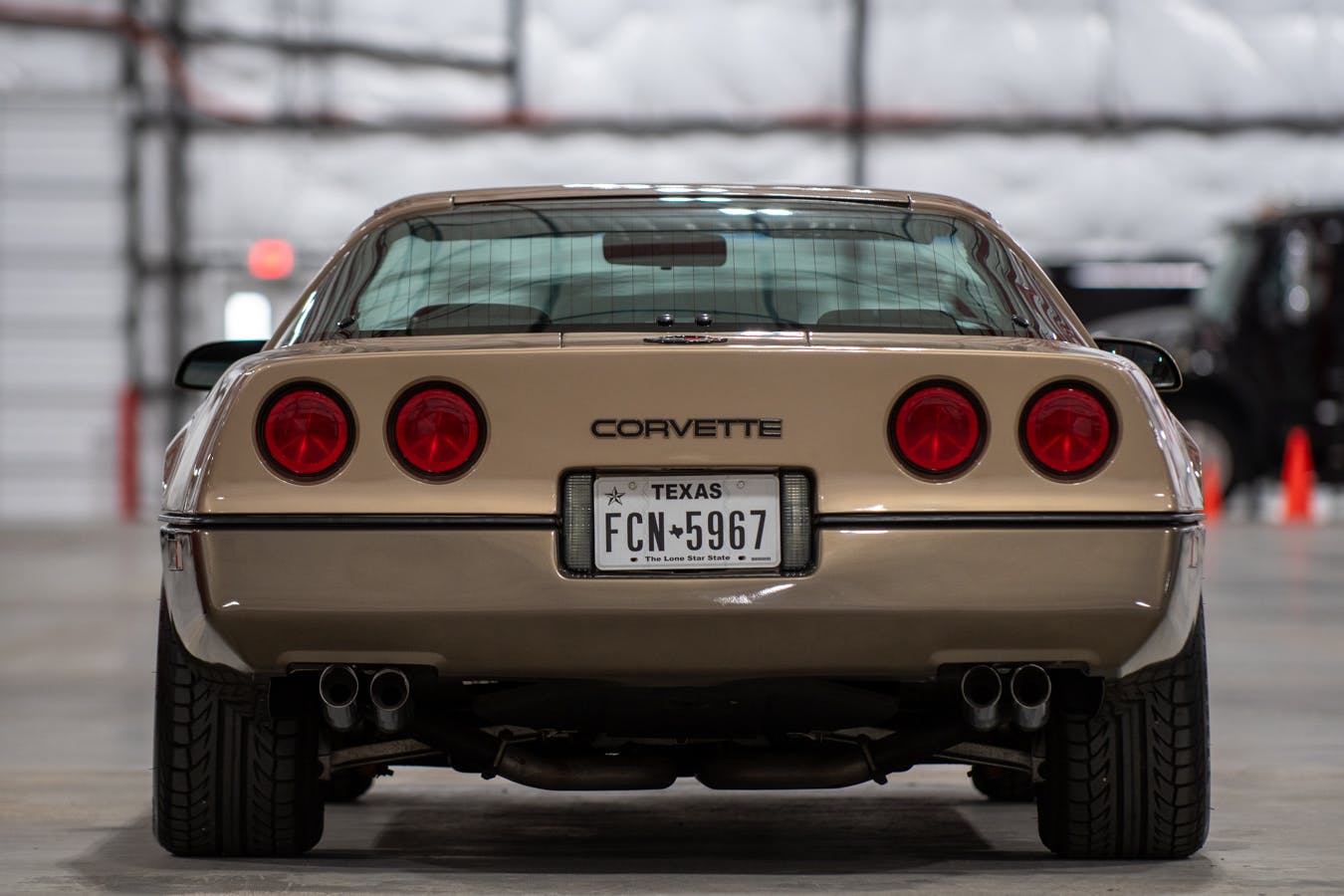
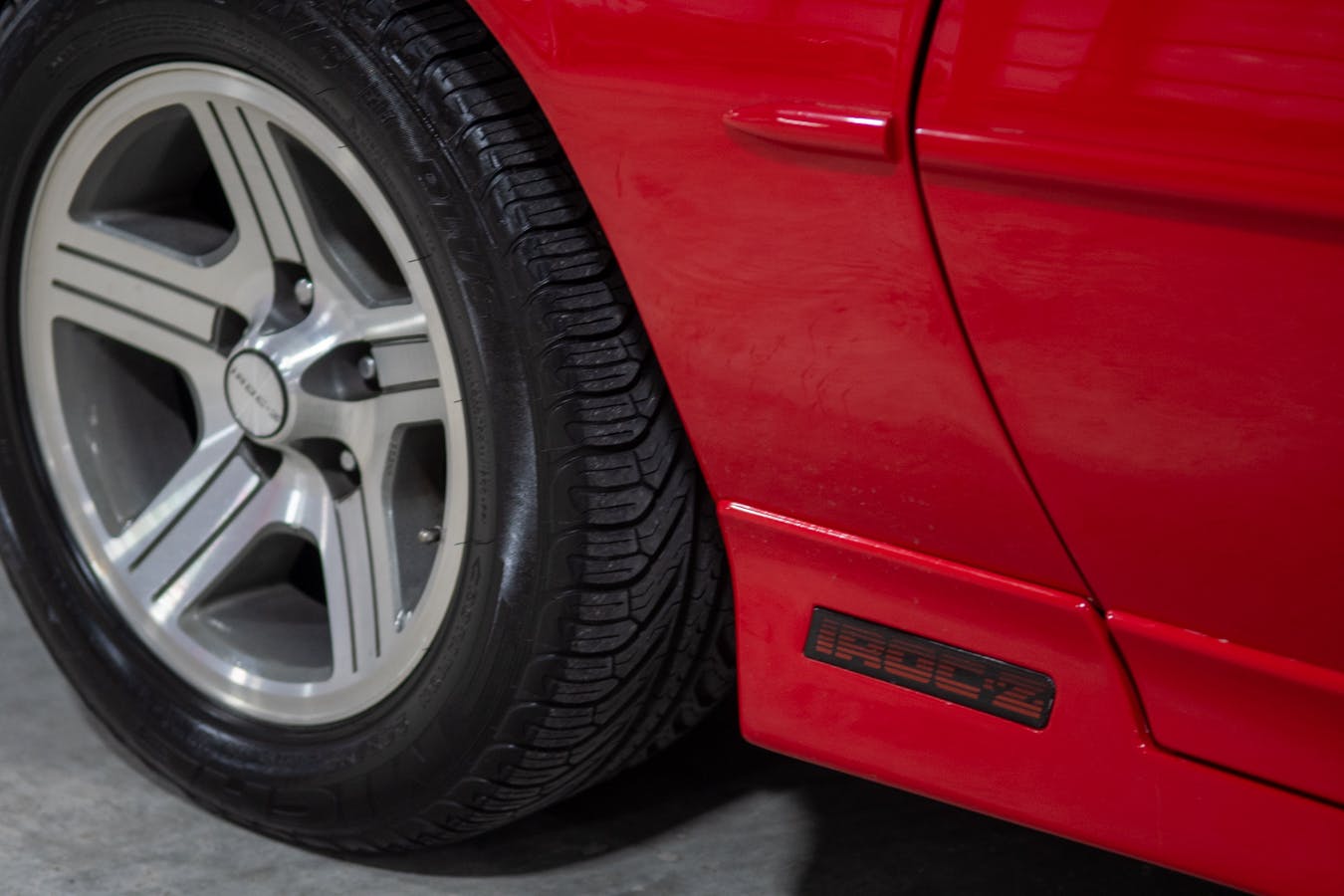
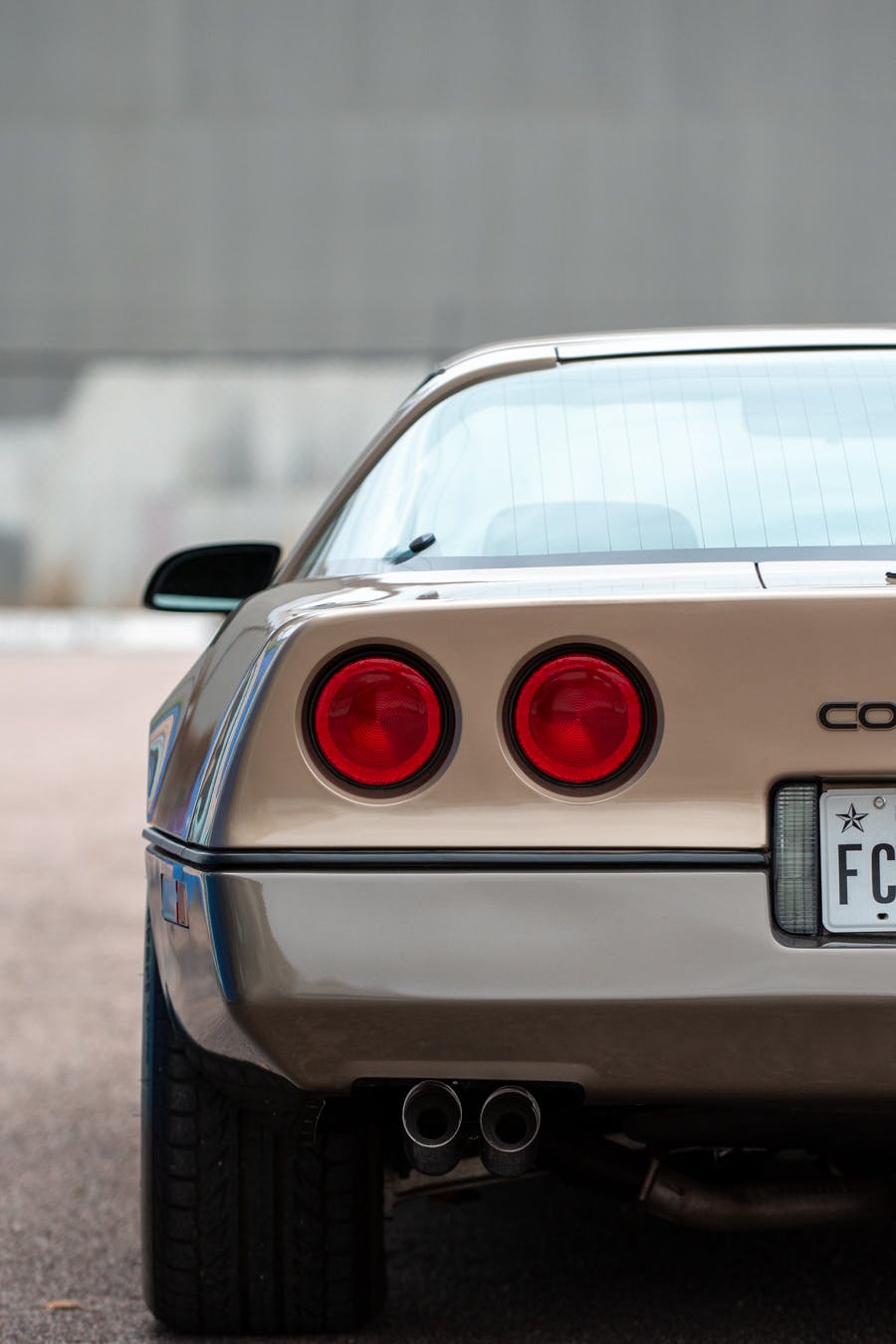
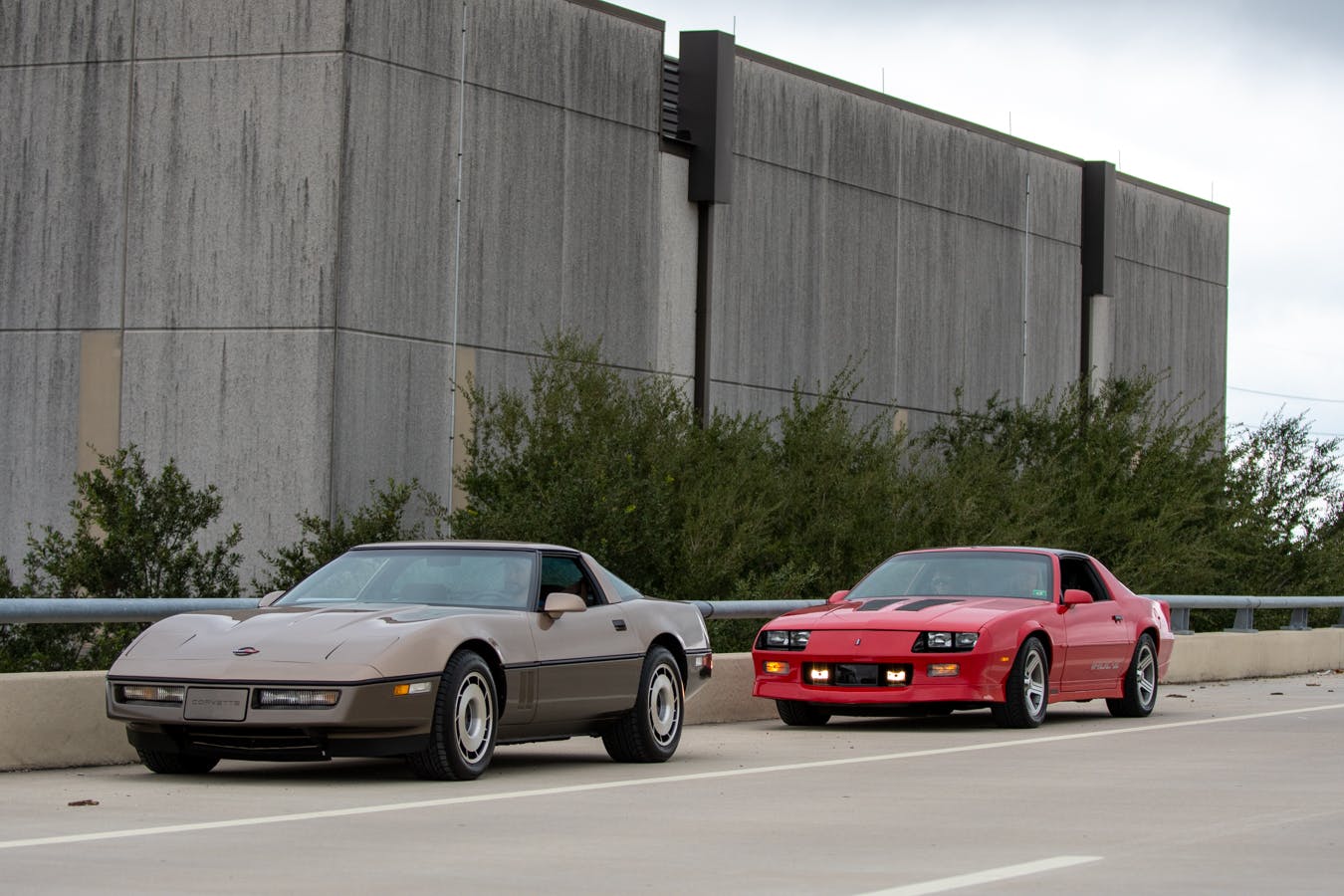
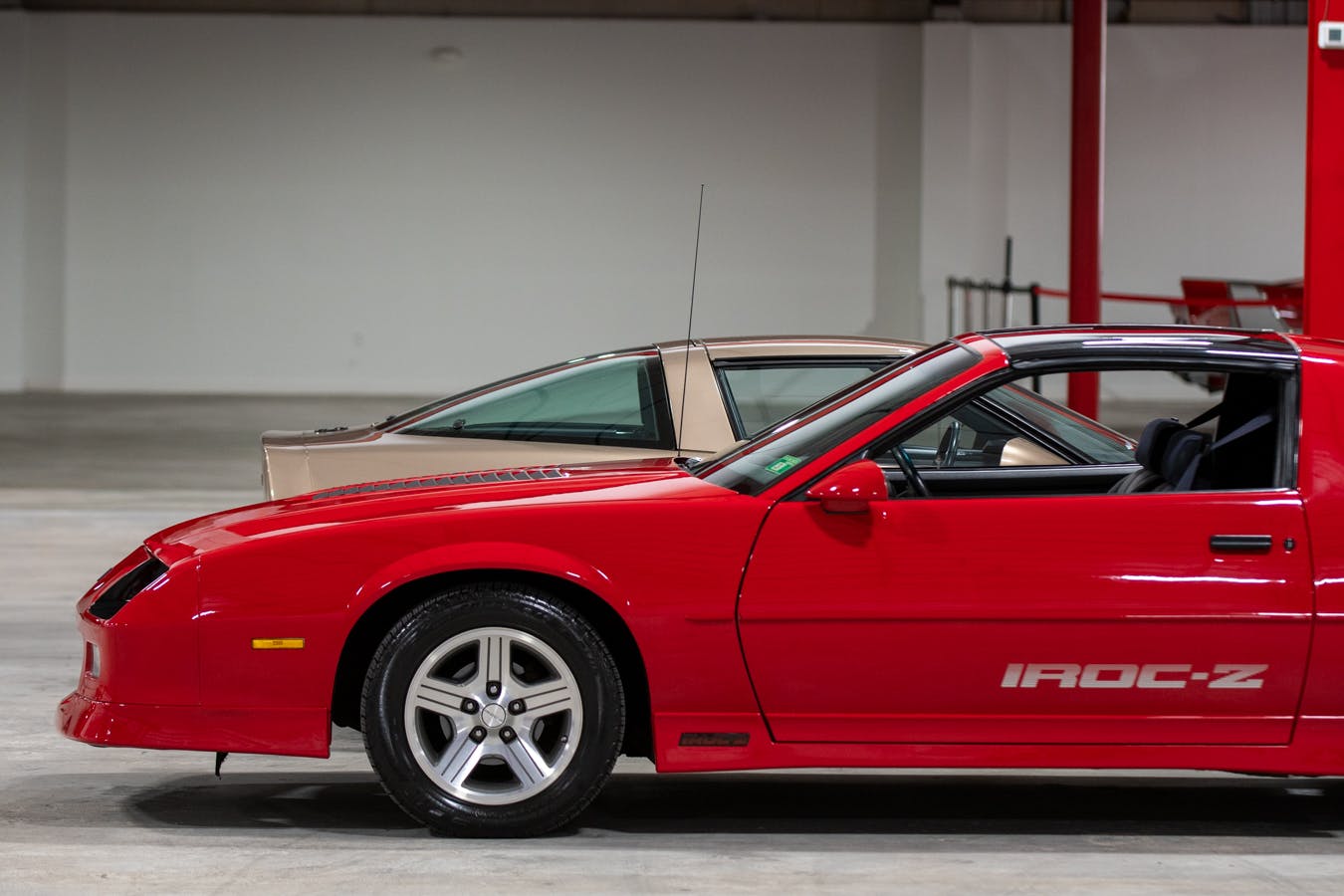
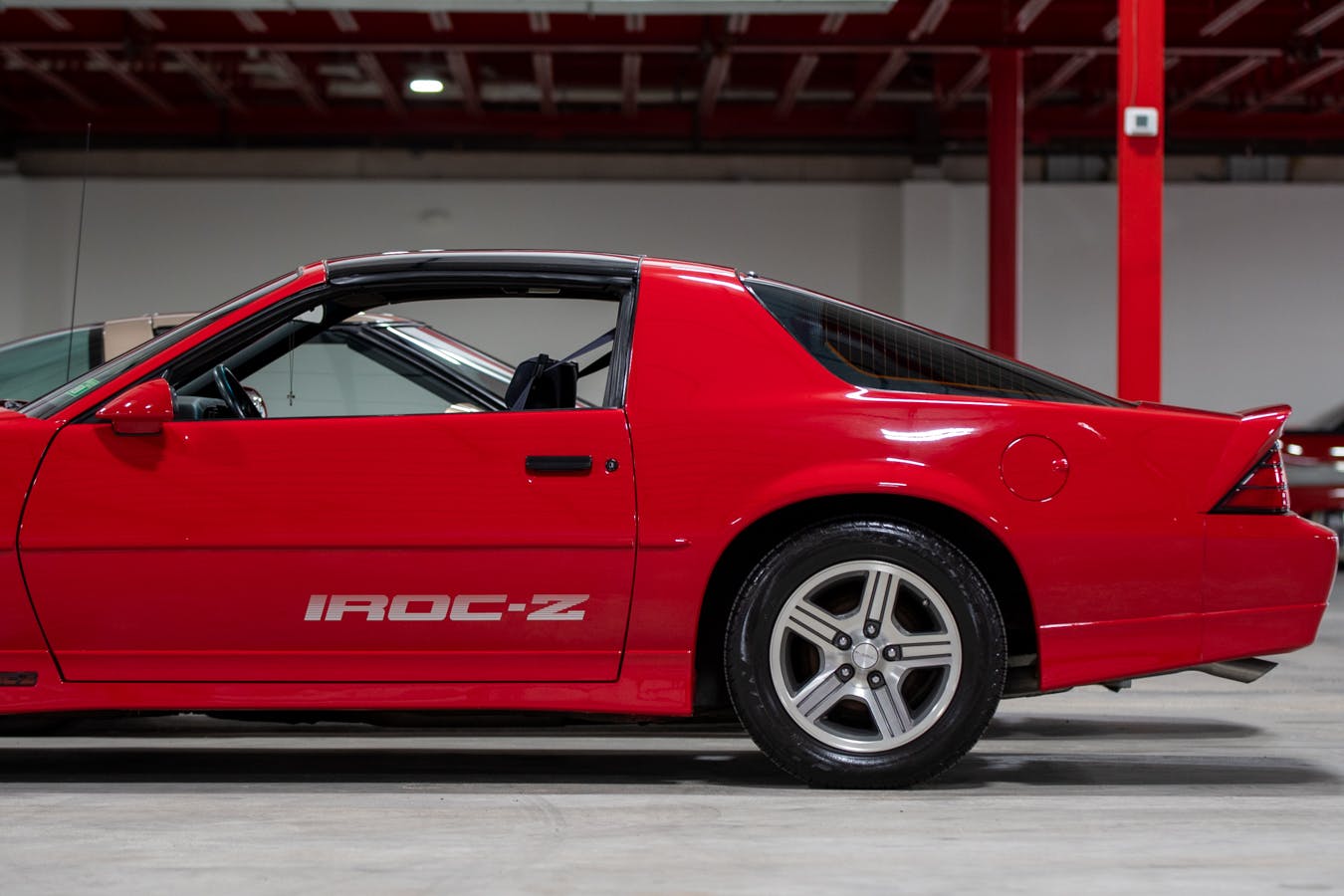























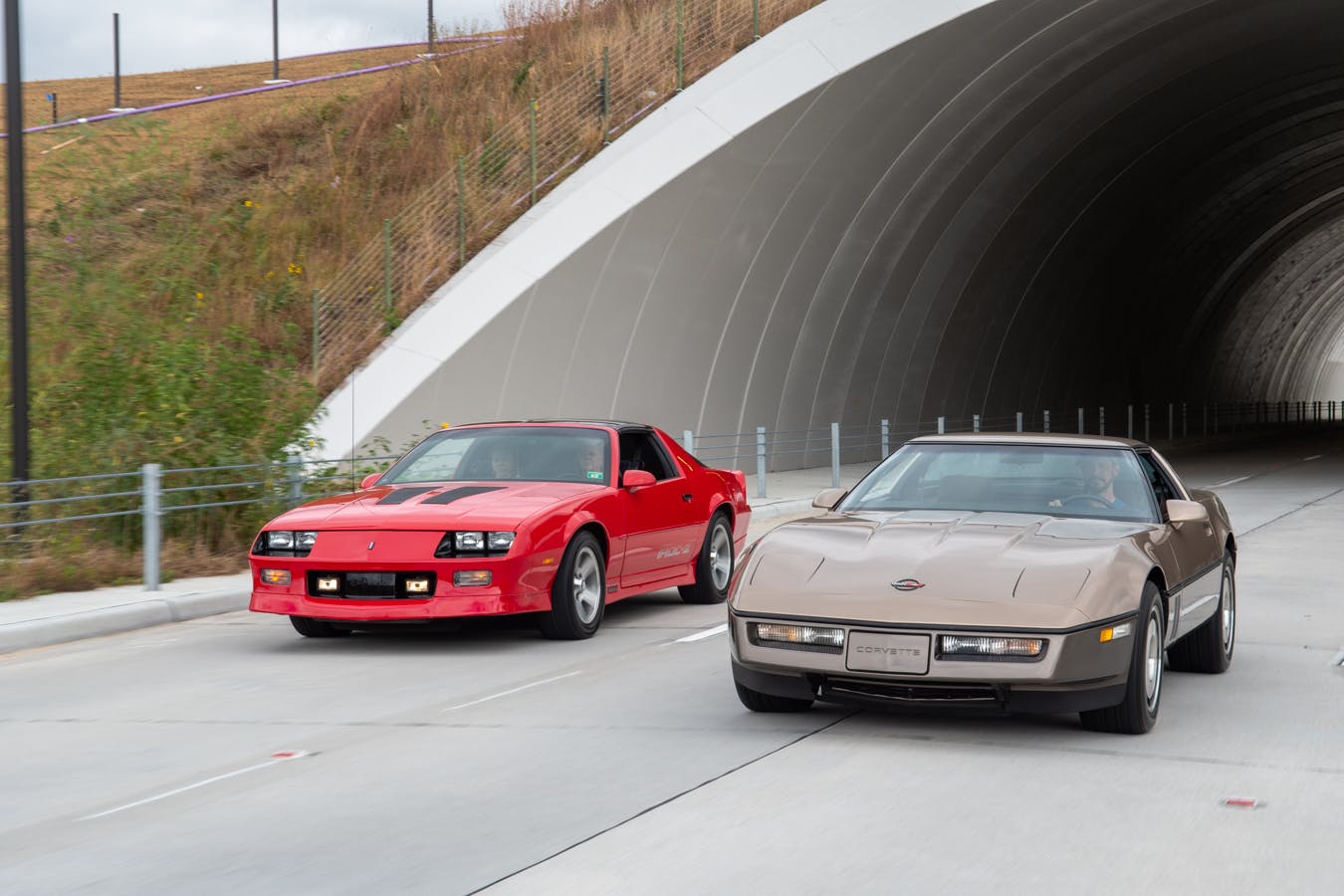
I think the C4 is an amazing bargain. The biggest things hurting its desirability is where it fits in with other Corvettes. C3s are a more dramatic swoopy body style and scratches the nostalgia itch. The C5s offer better performance, interior room, OBD2, LS engines, etc.
If I was in the C4 market my pick would be a 1990 ZR1, and 2nd Choice an 89 or 90 with 17 inch wheels and the 6 speed.
Neither are worth what my 57 Chevy Bel Air is worth & those things are ugly.
While I am not a big 55/6/7 fan, I don’t think 1957 Bel Airs are ugly – but to each his/her own.
57 Chevy’s peaked, IROC’s haven’t
Tri Five Chevys are pretty ugly in their own right. They’ll be worth half of what they are now in another ten years.
Every Gas car will be
Every Gas car will be
I liked my 4th gen LT1, 1LE Firebird formula. Except for the Opti spark. But my 84 Vette z51 with a big brake upgrade and soon to be horsepower boost is a riot to drive compared to the bird.
The two tone bronze is a bonus!
Good call. I’d like a final year C4 ZR1, but I’m so deep into my ’04 Holden/Pontiac 40th Anniversary GTO financially I don’t have enough cash to get one. Flip side, I see both Camaros and ‘Vettes from that era coming & going everyday; my Aussie made GTO? Almost never see one save for the few (5-6) in the Fargo region. And most of them are automatics. I would like my HS (’74-’78) mullet back, tho’; my head has become rather bare of late. Sigh.
Absolutely. It will go up in value, and I’ve called the car market several times. If I can get my hands on a 4+3 with a peeling clear coat for under $7500, you better believe that bad boy is going in storage until 2026, when it’ll run $25k.
I own a 1990 Chevrolet Camaro. Here are some specs of mine:
567 miles
5.7l V8
4 speed auto ‘
245 horsepower
Bose premium sound system (one of 300)
No scratches
As mentioned in the article, I really think it comes down to demographics. As a card carrying member of the Gen-X club myself, Thirdgen F-bodies (and their crosstown Fox body foes) were THE cars to have in the mid to late 80s high school parking lot. The Vette, while superior in many ways, was left to the dads and occasional rich kid that nobody liked. Also, the IROC and Trans Am just looked cooler. In place of the clean lines of the C4, they had racier stripes and spoilers-the things that appeal to youth. Now that I’m older, I do appreciate the C4, but the kid in me from 1987 wants that IROC (or GTA/Formula in my case) much more. And there’s on army of X’er like me with cash that feel the same way.
Well said!
I agree 100% with the article. I am a C4 owner, 1990 Edition, but prior to being able to obtain that I owned multiple Camaros and was a big fan of the IROC Z although the ultimate was the Corvette for me.
Perfectly summed up!! I have 2 Fox 5.0s and loved the IROCs. Never wanted an old man’s C4.
Wait a minute, Sajeev has a Corvette? All this time I thought he only had various Ford products. I’m familiar with Rob Siegel’s not-a-collection collection since he frequently mentions them all. I think it’d be fun to read about all the vehicles that the various writers have.
Someone on my paper route had the iroc-z in red like the one in the pictures. I wanted it when I was a kid. I think I’d still rather have it now. It looks more fun. Although it might not be… There’s probably a life lesson there that I still haven’t learned
Going to float a theory here: parts. The IROC may be special, but it’s still based on the 3rd-Gen F-Body. The Corvette, on the other hand, is its own exclusive line (and it’s fiberglass.) When you wad up an F-body, there are hundreds more in junk yards you can pull parts from. Wad up a C4 and you’re looking at thousands in repair costs.
There is overly dramatic plot afoot here.
It is simple supply and demand
The IROC was just a model of Camaro so they were less in number. Most were daily drivers that got used up soba clean low mile example is difficult to find.
It is still a nice looking car and one that is not easy to restore as many plastic parts are not available.
It also was a decent car.
On the other hand the C4 was mostly a weekend car for most. Many can still be found in low mile and never in rain condition.
Mix that with the fact there are even more C5 and C6 models that are more popular and even easier to find in low mile clean condition at a good price.
Folks there is just a ton of Corvettes out there that were driven on nice days wiped with a micro towel and covered. While the C4 was light years ahead of the C3 the following Models are just that much better than a C4.
The F bodies in these years are thought to find in great shape. I have judged many at Fbody events and they are rare to find in 3rd Gen mint condition. To make one in mint condition may cost more than it’s worth.
The same applies to 3rd Gen Trans Am and Formula models in great shape.
Many 80’s cars are hard to restore properly. To find one in original mint condition is going to be a big thing in the future.
Cars like a stock low mile GN is big money because most have been modified. Same will apply here. 4th gens in some variations will be some money but there are more of them saved as we knew they were going to die. This increased numbers.
The 80’s are growing in popularity as the 70’s cars of any value have seen prices rise. Also there so few interesting cars in this era. The 80’s started to try to bring some excitement and anything RWD will be popular if in good low mile condition.
Look for Fox Body low mile Mustangs in original condition take off at some point. The special editions already are.
I just picked up a 1988 Formula ASC convertible. Its all there but it has been driven with 146000 miles on it. I am having trouble finding the pricing on it because there were so few of them made.
Well said, hyperv6. Any Camaro will be easier to repair than the same year ‘Vette. I haven’t read all the comments, but my direct personal experience informs me that Corvettes are also much more expensive to insure and maintain. The C4 does have a sleek and mature aero look, where yon IROCs appear aggressive and angry. However, I prefer my “fat Cavalier” ’04 Pontiac/Holden GTO for the driving dynamics and style. And the Tremec is light-years better than the Nash 4+3.
To each his own. Thanks for your insight. R
Not so sure on the insurance front. When I was ~22 and car shopping, a C5Z was significantly less to insure than the other cars I was looking at (4th Gen TA, GTO, Terminator Cobra).
The same holds true for most C3 Corvettes. Unless it’s a 427, or an LT-1 or similar, chrome bumper C3’s lag behind even the most mundane first gen Camaro. I think it’s because the audience for these cars are 50-60 years old or older, and let’s be honest, Corvettes are not easy to get in and out of for most people who are that age. As a result, they’re not as popular.
I’m 65, own a 73 C3, 454 turbo, 425 hp, munci 4 speed M21 close ratio, 3.5 gears, and can easily get in and out. It’s the g force throwing you into the seat that’s the challenge. Had. 71 Z28 in my 20s . No comparison to my C3.
Well said Steve I have a 1970 350 350 HP Great Feeling.
Between these two I give the edge to the Camaro in what I would want. However if that C4 was a ZR1 then it would be no contest as that is the prettiest motor around.
Hey Gary,, did you ever live in Yorba Linda, briefly on W***W*** lane? If so,, I’m the teenager who used to live next door.
What many forget is the ZR1 was the peak in C4 performance and it was easily surpassed by the next gen V8. In fact GM delayed it as they did not want the ZR buyers to feel slighted for paying more and getting less.
Sort of, as the LS1 only had 345 hp and the ZR-1 had 405hp. The C5 was a better platform for most dynamic tests, the LS1 wasn’t necessarily better out of the box. What many forget is that the LT-5 was de-stroked as per Chevy (not Lotus) requirements and had it remained a 368-ish cubic inch small block it woulda absolutely destroyed the LS-series engines for several years.
https://www.lingenfelter.com/product/JE120932.html
you are rating corvettes on horsepower, most have more then ample power, some series are more pleasant to drive, some have more friendly interiors, some handle very poorly. I have had a very large variety of vettes over the years and i still have a few . my 1990 ZR1 is a nice car, the 2015 Z06 is a much better car, the 2007 is the most fun to drive, it does everything perfectly with only 400 hp ( they are all shifts). For me horsepower doesn’t make the car, it would if I was going to the track Z06 hands down.
You are so right in your analysis. It isn’t the sheer horsepower that makes the car. If I had my druthers I too would love to drive the mid-2000s Vette notchback and never look back.
Arthur, not sure why you said that, as I readily admitted the C5 is a “better platform for most dynamic tests” in my comment. A way better platform, in fact.
And now I’ll just go ahead and suggest that a proper Lotus engineered (i.e. not a hamstrung 350-cid) LT-5 in a Corvette C5 woulda been astoundingly fast with no detriment to any other dynamic maneuver. An LT-5 in a C5 woulda been the car to beat on any race track, especially the ones with long straightaways.
Perhaps it would need a bit of suspension tweaking because of the DOHC’s extra weight, and it assumes an LT-5 would actually fit under the C5’s hood. Details, details, details…
IIRC, the C5 was originally supposed to have the LT-5 as an engine. It is supposed to fit under the cowl.
When I say “have”, I meant that it was engineered to accommodate, not that it was supposed to have the LT-5 instead of the LS.
I heard that too, but I never looked into how true that was, or if its just a rumor.
For years the magazines printed “C4 the only Corvette named after the best way to dispose of it”…
Literally 20+ years of being reviled as a poor vette, a certain demographic (not cool) car, etc.
There’s a reason Roadkill cut one up (and Hot Rod did years before) in that more of the audience would be amused than upset (and the upset was buzz).
Also, the high survivor rate of Vettes is going to hurt the values of the least-desirable Vette.
Own what you think is cool and don’t worry about the market. I’ve considered a C4 vette in recent years myself. The underdog rep appeals to me and there is a lot to like in the package. I haven’t driven one though and that matters the most to me (if it doesn’t “fit” me well why bother).
Sajeev’s Corvette is the best looking early C4 I have seen in years!
I’ll address the gorilla in the room which is practicality. The C4 is an amazing car, but as a daily driver where you might have to pick up groceries and a kid or two it comes up short compared to the Camaro . Granted the Camaro isn’t perfect, the only way you’ll haul adults in the back seat is if they are under 5’5″ and if you and your front seater keep the seats far forward. Unlike the Corvette though, if you do so you can share the thrill of speed with 3 of your friends as opposed to just one.
Having grown up in that era:
C4s were 3rd/4th vehicles used sparingly and garaged in doors. They were purchased by well established baby boomers on the heels of figuring out C1/C2 cars were going up and sure to be worth big money. As such, they were cared for, used sparingly, and presumed to be valuable. When sold, they were sold laterally to a similar buyer with similar expectations… that were never met.
IROC Camaros were special, but they were still just regular cars. They were cool daily drivers that racked up miles, got parked outside, and were eventually sold down to used car buyers as affordable transportation or a first car for a kid 90s (me). They were gutted, raced, wrecked, engine swapped, sun faded, and rusty.
As such, very few nice IROC Camaros survived and there are way more 40-60 year old peak earners that might remember their uncles C4, but they are willing to pay dearly for their first car or the IROC they always wanted…
but there are so few left to choose from, that the market naturally gets pushed up.
All while tens of thousands of C4 owners keep polishing their Corvette and pulling it back garage… sure the prices are going to go up next year.
So true. I picked up 92 R/S with a 305 and 5-speed stick in 94. It was my daily driver for over 15 years. Drove it in snow and ice, picked up the kids from daycare, child safety seats, and so on. Everything you might do in a Toyota Camry. Except this one had the performance of a typical 80’s motorcycle which I also owned.
Eventually, I started having problems with the EFI system and no one knows how to fix those pre-OBCII ones anymore. If they can’t plug a computer into it, they are lost. Eventually I replaced the entire system with a Holley Stealth/Sniper system. It still needs a little body work and new paint job, but it now lives the weekend driver life of the C4.
Mike…..you’re my hero. I dumped my rs to a veteran who bought it with his Iraq war money.
I was happy to see it go to a better guy then me!
Then at 28 I wrecked my 99 frc c5 after a wedding going up a hill in the rain that we used to ‘race’ up on the way from high school.
Good times. I miss being young and wreckless and stupid.
Baby mamas have killed my spirit. But kids are fun!
How many miles are on your 92 rs? I’m impressed. I could not daily drive a 92 Camaro that long. I’m not man enough to take the punishment.
I am original owner
1990 IROC Convertible
8500 original miles
White Exterior Grey Leather Interior
Gets as Much attention then my
2021 C8 3lt Z51 Corvette
Love em both
Can you do 1994-96 Impalas vs 1994-96 Corvettes next?
I’m sure some have also noticed that unmodified, clean and all original 83-88 Monte Carlo SS are not only hard to find but hard to find under 20k at this point. The market for them is probably less than either the Iroc or Corvette, so long term values may just plateau and that be it. Any thoughts on these other 80’s nostalgia rides? I’m also of the idea that you should get what appeals to you from the past and not worry about the “value” and just have fun driving it. ?
We are super salty rust belt so attrition has been hard on most things.
Corvettes, Cadillacs, Lincolns, etc. were kept in garages or carports and often owned for 20-30 years by the same original owner. High survival rate. Not always high value compared to original sales bracket.
The 94-96 Impala SS is strong, and has sprinkled fairy dust on all the related models (i.e., Buick Roadmaster wagons are pricey here). This has even impacted the previous gen Impalas in that the 4 doors are getting pricey for what they are and the 2-doors were always rare.
Grand Nationals lead the way I would think, but all the G-body GM stuff is appreciated. Basically Chevelle/GTO/Cutlass/GS A body era 2.0. Being the last frame-on vehicle in 55-57 Chev wheelbase likely helps a lot as this is the sweet size of car for doing things with people but also rodding/racing.
People that don’t care about frame on have been doing Fox body for decades… lots of these cars (and Camaros) got used up, but the sheer volume of them has always meant that they get stripped for parts, turned into race cars and so on. Worse examples of these have been kept in people’s back yards for years when almost mint Buicks were getting scrapped.
Did you say “hard to find”??? Check out the next low rider car show.